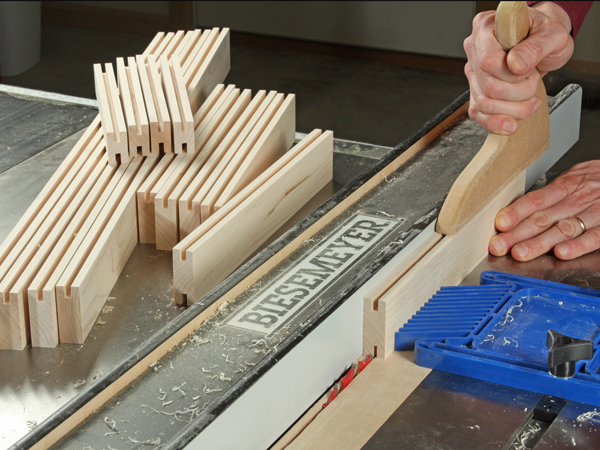
What are the advantages of having a fence that is longer than standard (I am not referring to the length of the rail or “ripping capacity”)? I can readily see the advantage of having a long distance at the front, from the front to the cutting edge of the blade. The more length for the work to lean on the better. What are the advantages of having a greater distance at the rear? I would say that for through cuts there are few advantages, but for grooving there are. This is because for grooving you can exert pressure for the entire length of the work . What do you think?
Ian Kirby: You can perform four operations on a table saw.
– Rip solid wood
– Cut man-made sheet materials (MMSM)
– Cross Cut
– Shape
The fence, the splitter and the top guard each are set up to perform the work correctly – and perform it in a fundamentally safe manner.
When ripping solid wood, the fence should end near the arbor but no further than where the saw teeth exit the insert. The splitter is vital. This setup allows the wood to distort, which it can do violently, immediately after it’s cut. If the fence goes beyond the blade, the distorted workpiece is thrust into the rising teeth of the blade, and that’s a prelude to a kickback. The splitter is the savior, especially if the distortion closes the kerf tightly.
Cutting MMSM has the fence going across the table, since particle board and medium density fiberboard doesn’t distort at all and plywood distorts little and then only rarely. Nevertheless, the splitter is a vital part of the setup.
Cross cutting doesn’t figure into the length of the fence.
Shaping grooves and rabbets should have the fence going all the way across the table. The splitter isn’t used and you should stand as you would at a shaper: so you can see and feel contact between the workpiece and the fence throughout a cut.
Rick White: This, as you might guess, depends on the size of the piece you’re cutting. If you have a 12″ board, a short fence should be fine. If you’re cutting a 6′ board, then you need all the control you can get and a longer fence will give you that. Ask yourself how much guidance do you need for each cut. Up to a point, a longer fence is better.
Rob Johnstone: Long fences provide more control on larger pieces of stock by allowing you to slide the piece beyond the cutter with ease. There are a few situations where the long fence can cause problems. For example, when ripping rough hardwood to width, sometimes there are curved edges or convex edges that would be less affected by a shorter fence…but in general, my thought is: longer is better.
Ellis Walentine: A longer fence is marginally more useful when you’re cutting large pieces of sheet goods, because you have more contact at the outboard end for guiding those pieces past the blade in a straight line. For ripping solid wood, the extra length could be more hindrance than help. A lot of people prefer a short, partial fence for solid stock; that is, the fence ends just past the blade. This is to prevent reactive stock from getting pinched by the outboard end of the fence. I like the Delta Unifence’s (and a couple others’) adjustability fore and aft. It lets you choose the fence position that best suits the job.







